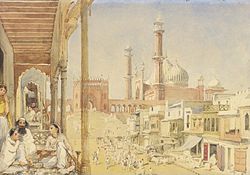| Jama Masjid | |
|---|---|
 | |
| Basic information | |
| Location | Delhi, India |
| Geographic coordinates | 28°39′3″N 77°13′59″E / 28.65083°N 77.23306°ECoordinates: 28°39′3″N 77°13′59″E / 28.65083°N 77.23306°E |
| Affiliation | Islam |
| Territory | Delhi |
| District | Central Delhi |
| Ecclesiastical status | Mosque |
| Architectural description | |
| Architectural type | Mosque |
| Architectural style | Islamic, |
| Year completed | 1656 |
| Specifications | |
| Capacity | 25,000 |
| Length | 80 m |
| Width | 27 m |
| Dome(s) | 3 |
| Minaret(s) | 2 |
| Minaret height | 41 m |
| Spire height | 40000 m |
The Masjid-i Jahān-Numā (Persian: مسجد جھان نما, the 'World-reflecting Mosque'), commonly known as the Jama Masjid of Delhi, is the principal mosque of Old Delhi in India. Commissioned by the Mughal Emperor Shah Jahan, builder of the Taj Mahal, and completed in the year 1656 AD, it is the largest and best-known mosque in India. The name Jahān-Numā comes from Persian meaning "World-reflecting". It lies at the origin of a very busy central street of Old Delhi, Chandni Chowk.
The later name, Jami Masjid, is a reference to the weekly Friday noon congregation prayers of Muslims, Jummah, which are usually done at a mosque, the "congregational mosque" or "jāmi' masjid". The courtyard of the mosque can hold up to twenty-five thousand worshippers. The mosque also houses several relics in a closet in the north gate, including an antique copy of the Qur'an written on deer skin.
Construction
The foundation of the historic Jama Masjid (Friday Mosque) was laid on a hillock in Shahjahanabad by fifth Mughal Emperor of India, Shahjahan, on Friday the October 6, 1650 AD, (10th Shawwal 1060 AH). The mosque was the result of the efforts of over 5,000 workers, over a period of six years.. The cost incurred on the construction in those times was 10 lakh (1 million) Rupees, and it was same Emperor who also built the who built the Taj Mahal, at Agra and the Red Fort, which stands across the Jama Masjid, which was finally ready in 1656 AD (1066 AH), complete with three great gates, four towers and two 40 m-high minarets constructed of strips of red sandstone and white marble.
Shah Jahan built several important mosques in Delhi, Agra, Ajmer and Lahore. The Jama Masjid's floorplan is very similar to the Jama Masjid, Fatehpur Sikri near Agra, but the Jamia Masjid is the bigger and more imposing of the two. Its majesty is further enhanced because of the high ground that he selected for building this mosque. The architecture and design of the slightly larger Badshahi Mosque of Lahore built by Shah Jahan's son Aurangzeb in 1673 is closely related to the Jamia Masjid in Delhi.
Architecture
The courtyard of the mosque can be reached from the east, north and south by three flights of steps, all built of red sandstone. The northern gate of the mosque has 39 steps. The southern side of the mosque has 33 steps. The eastern gate of the mosque was the royal entrance and it has 35 steps. These steps used to house food stalls, shops and street entertainers. In the evening, the eastern side of the mosque used to be converted into a bazaar for poultry and birds in general. Prior to the 1857 War of Indian Independence, there was a madrassah near the southern side of the mosque, which was pulled down after the mutiny.
The mosque faces west. Its three sides are covered with open arched colonnades, each having a lofty tower-like gateway in the centre. The mosque is about 261 feet (80 m) long and 90 feet (27 m) wide, and its roof is covered with three domes with alternate stripes of black and white marble, with its topmost parts covered with gold. Two lofty minarets, 130 feet (41 m) high, and containing 130 steps, longitudinally striped with white marble and red sandstone, flank the domes on either side. The minarets are divided by three projecting galleries and are surmounted by open twelve-sided domed pavilions. On the back of the mosque, there are four small minarets crowned like those in the front.
Under the domes of the mosque, is a hall with seven arched entrances facing the west and the walls of the mosque, up to the height of the waist, are covered with marble. Beyond this is a prayer hall, which is about 61 meters X 27.5 meters, with eleven arched entrances, of which the centre arch is wide and lofty, and in the form of a massive gateway, with slim minarets in each corner, with the usual octagonal pavilion surmounting it. Over these arched entrances there are tablets of white marble, four feet (1.2 m) long and 2.5 feet (760 mm) wide, inlaid with inscriptions in black marble. These inscriptions give the history of the building of the mosque, and glorify the reign and virtues of Shah Jahan. The slab over the centre arch contains simply the words "The Guide!"
The mosque stands on a platform of about five feet (1.5 m) from the pavement of the terrace, and three flight of steps lead to the interior of the mosque from the east, north, and the south. The floor of the mosque is covered with white and black marble ornamented to imitate the Muslim prayer mat; a thin black marble border is marked for the worshippers, which is three feet long and 1 ½ feet wide. In total there are 899 such spaces marked in the floor of the mosque. The back of the mosque is cased over to the height of the rock on which the mosque stands with large hewn stones.
2006 explosions
On April 14, 2006, two explosions occurred within Jamia Masjid. The first explosion came at around 17:26 and the second around seven minutes later at around 17:33 (IST) . At least thirteen people were injured in the blasts. There were around 1000 people in the mosque at the time of blasts as the day happened to be Friday, a Muslim holy day, and because it was the first Friday after Milad un Nabi, Islamic prophet Muhammad's birthday. According to official spokesmen, there was no damage to the mosque itself.




















0 Comments:
Post a Comment